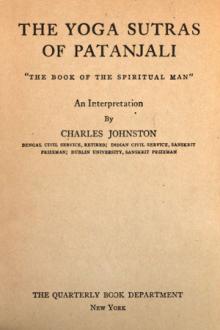An Introduction to Yoga by Annie Besant (recommended reading .TXT) 📖

- Author: Annie Besant
- Performer: 8170590507
Book online «An Introduction to Yoga by Annie Besant (recommended reading .TXT) 📖». Author Annie Besant
Along such lines you can learn to bring into control your mind, to discipline your vagrant thought, and thus to reach illumination. One word of warning. You cannot do this, while you are trying meditation with a seed. until you are able to cling to your seed definitely for a considerable time, and maintain throughout an alert attention. It is the emptiness of alert expectation. not the emptiness of impending sleep. If your mind be not in that condition, its mere emptiness is dangerous. It leads to mediumship, to possession, to obsession. You can wisely aim at emptiness, only when you have so disciplined the mind that it can hold for a considerable time to a single point and remain alert when that point is dropped.
The question is sometimes asked: “Suppose that I do this and succeed in becoming unconscious of the body; suppose that I do rise into a higher region; is it quite sure that I shall come back again to the body? Having left the body, shall I be certain to return?” The idea of non-return makes a man nervous. Even if he says that matter is nothing and Spirit is everything, he yet does not like to lose touch with his body and, losing that touch, by sheer fear, he drops back to the earth after having taken so much trouble to leave it. You should, however, have no such fear.
That which will draw you back again is the trace of your past, which remains under all these conditions.
The question is of the same kind as: “Why should a state of Pralaya ever come to an end, and a new state of Manvantara begin?” And the answer is the same from the Hindu psychological standpoint; because, although you have dropped the very seed of thought, you cannot destroy the traces which that thought has left, and that trace is a germ, and it tends to draw again to itself matter, that it may express itself once more. This trace is what is called the privation of matter— samskara. Far as you may soar beyond the concrete mind, that trace, left in the thinking principle, of what you have thought and have known, that remains and will inevitably draw you back. You cannot escape your past and, until your life-period is over, that samskara will bring you back. It is this also which, at the close of the heavenly life, brings a man back to rebirth. It is the expression of the law of rhythm. In Light on the Path, that wonderful occult treatise, this state is spoken of and the disciple is pictured as in the silence. The writer goes on to say: “Out of the silence that is peace a resonant voice shall arise. And this voice will say: ‘It is not well; thou hast reaped, now thou must sow.’ And knowing this voice to be the silence itself, thou wilt obey.”
What is the meaning of that phrase: “Thou hast reaped, now thou must sow?” It refers to the great law of rhythm which rules even the Logoi, the Ishvaras —the law of the Mighty Breath, the out-breathing and the in-breathing, which compels every fragment which is separated for a time. A Logos may leave His universe, and it may drop away when He turns His gaze inward, for it was He who gave reality to it.
He may plunge into the infinite depths of being, but even then there is the samskara of the past universe, the shadowy latent memory, the germ of maya from which He cannot escape. To escape from it would be to cease to be Ishvara, and to become Brahma Nirguna. There is no Ishvara without maya, there is no maya without Ishvara. Even in pralaya, a time comes when the rest is over and the inner life again demands manifestation; then the outward turning begins and a new universe comes forth. Such is the law of rest and activity: activity followed by rest; rest followed again by the desire for activity; and so the ceaseless wheel of the universe, as well as of human lives, goes on. For in the eternal, both rest and activity are ever present, and in that which we call Time, they follow each other, although in eternity they be simultaneous and ever-existing.
The Use of Mantras
Let us see how far we can help ourselves in this difficult work.
I will draw your attention to one fact which is of enormous help to the beginner.
Your vehicles are ever restless. Every vibration in the vehicle produces a corresponding change in consciousness. Is there any way to check these vibrations, to steady the vehicle, so that consciousness may be still? One method is the repeating of a mantra. A mantra is a mechanical way of checking vibration.
Instead of using the powers of the will and of imagination, you save these for other purposes, and use the mechanical resource of a mantra. A mantra is a definite succession of sounds. Those sounds, repeated rhythmically over and over again in succession, synchronise the vibrations of the vehicles into unity with themselves. Hence a mantra cannot be translated; translation alters the sounds. Not only in Hinduism, but in Buddhism, in Roman Catholicism, in Islam, and among the Parsis, mantras are found, and they are never translated, for when you have changed the succession and order of the sounds, the mantra ceases to be a mantra. If you translate the words, you may have a very beautiful prayer, but not a mantra. Your translation may be beautiful inspired poetry, but it is not a living mantra. It will no longer harmonise the vibrations of the surrounding sheaths, and thus enable the consciousness to become still. The poetry, the inspired prayer, these are mentally translatable. But a mantra is unique and untranslatable. Poetry is a great thing: it is often an inspirer of the soul, it gives gratification to the ear, and it may be sublime and beautiful, but it is not a mantra.
Attention
Let us consider concentration. You ask a man if he can concentrate. He at once says: “Oh! it is very difficult. I have often tried and failed.” But put the same question in a different way, and ask him: “Can you pay attention to a thing?” He will at once say: “Yes, I can do that.”
Concentration is attention. The fixed attitude of attention, that is concentration. If you pay attention to what you do, your mind will be concentrated. Many sit down for meditation and wonder why they do not succeed. How can you suppose that half an hour of meditation and twenty-three and a half hours of scattering of thought throughout the day and night, will enable you to concentrate during the half hour? You have undone during the day and night what you did in the morning, as Penelope unravelled the web she wove. To become a Yogi, you must be attentive all the time. You must practice concentration every hour of your active life. Now you scatter your thoughts for many hours, and you wonder that you do not succeed. The wonder would be if you did.
You must pay attention every day to everything you do. That is, no doubt, hard to do, and you may make it easier in the first stages by choosing out of your day’s work a portion only, and doing that portion with perfect, unflagging attention. Do not let your mind wander from the thing before you. It does not matter what the thing is. It may be the adding up of a column of figures, or the reading of a book. Anything will do. It is the attitude of the mind that is important and not the object before it. This is the only way of learning concentration. Fix your mind rigidly on the work before you for the time being, and when you have done with it, drop it. Practise steadily in this way for a few months, and you will be surprised to find how easy it becomes to concentrate the mind. Moreover, the body will soon learn to do many things automatically. If you force it to do a thing regularly, it will begin to do it, after a time, of its own accord, and then you find that you can manage to do two or three things at the same time. In England, for instance, women are very fond of knitting. When a girl first learns to knit, she is obliged to be very intent on her fingers. Her attention must not wander from her fingers for a moment, or she will make a mistake.
She goes on doing that day after day, and presently her fingers have learnt to pay attention to the work without her supervision, and they may be left to do the knitting while she employs the conscious mind on something else. It is further possible to train your mind as the girl has trained her fingers. The mind also, the mental body, can be so trained as to do a thing automatically. At last, your highest consciousness can always remain fixed on the Supreme, while the lower consciousness in the body will do the things of the body, and do them perfectly, because perfectly trained. These are practical lessons of Yoga.
Practice of this sort builds up the qualities you want, and you become stronger and better, and fit to go on to the definite study of Yoga.
Obstacles to Yoga
Before considering the capacities needed for this definite practice, let us run over the obstacles to Yoga as laid down by Patanjali.
The obstacles to Yoga are very inclusive. First, disease: if you are diseased you cannot practice Yoga; it demands sound health, for the physical strain entailed by it is great. Then languor of mind: you must be alert, energetic, in your thought. Then doubt: you must have decision of will, must be able to make up your mind. Then carelessness: this is one of the greatest difficulties with beginners; they read a thing carelessly, they are inaccurate. Sloth: a lazy man cannot be a Yogi; one who is inert, who lacks the power and the will to exert himself; how shall he make the desperate exertions wanted along this line? The next, worldly-mindedness, is obviously an obstacle. Mistaken ideas is another great obstacle, thinking wrongly about things. One of the great qualifications for Yoga is “right notion” “Right notion”
means that the thought shall correspond with the outside truth; that a man shall he fundamentally true, so that his thought corresponds to fact; unless there is truth in a man, Yoga is for him impossible. Missing the point, illogical, stupid, making the important, unimportant and vice versa. Lastly, instability: which makes Yoga impossible, and even a small amount of which makes Yoga futile; the unstable man cannot be a yogi.
Capacities of Yoga
Can everybody practise Yoga? No. But every well-educated person can prepare for its future practice. For rapid progress you must have special capacities, as for anything else. In any of the sciences a man may study without being the possessor of very special capacity, although he cannot attain eminence therein; and so it is with Yoga. Anybody with a fair intelligence may learn something from Yoga which he may advantageously practice, but he cannot hope unless he starts with certain capacities, to be a success in Yoga





Comments (0)